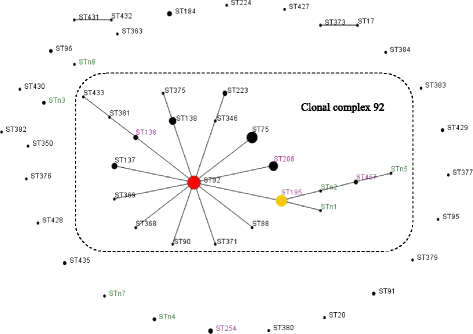Pneumonia caused by extensive drug-resistant Acinetobacter baumannii among hospitalized patients: genetic relationships, risk factors and mortality
- PMID: 28558660
- PMCID: PMC5450129
- DOI: 10.1186/s12879-017-2471-0
Pneumonia caused by extensive drug-resistant Acinetobacter baumannii among hospitalized patients: genetic relationships, risk factors and mortality
Abstract
Background: The clonal spread of multiple drug-resistant Acinetobacter baumannii is an emerging problem in China. We analysed the molecular epidemiology of Acinetobacter baumanni isolates at three teaching hospitals and investigated the risk factors, clinical features, and outcomes of hospital-acquired pneumonia caused by extensive drug-resistant Acinetobacter baumannii (XDRAB) infection in Guangzhou, China.
Methods: Fifty-two A. baumannii isolates were collected. Multilocus sequence typing (MLST) was used to assess the genetic relationships among the isolates. The bla OXA-51-like gene was amplified using polymerase chain reaction (PCR) and sequencing. The resistance phenotypes were determined using the disc diffusion method. A retrospective case-control study was performed to determine factors associated with XDRAB pneumonia.
Results: Most of the 52 A. baumannii isolates (N = 37, 71.2%) were collected from intensive care units (ICUs). The respiratory system was the most common bodily site from which A. baumannii was recovered (N = 45, 86.5%). Disc diffusion classified the isolates into 17 multidrug-resistant (MDR) and 35 extensively drug-resistant (XDR) strains. MLST grouped the A. baumannii isolates into 5 existing sequence types (STs) and 7 new STs. ST195 and ST208 accounted for 69.2% (36/52) of the isolates. The clonal relationship analysis showed that ST195 and ST208 belonged to clonal complex (CC) 92. According to the sequence-based typing (SBT) of the bla OXA-51-like gene, 51 A. baumannii isolates carried OXA-66 and the rest carried OXA-199. There were no significant differences with respect to the resistance phenotype between the CC92 and non-CC92 strains (P = 0.767). The multivariate analysis showed that the APACHE II score, chronic obstructive pulmonary disease (COPD) and cardiac disease were independent risk factors for XDRAB pneumonia (P < 0.05). The mortality rate of XDRAB pneumonia was high (up to 42.8%), but pneumonia caused by XDRAB was not associated with in-hospital mortality (P = 0.582).
Conclusions: ST195 may be the most common ST in Guangzhou, China, and may serve as a severe epidemic marker. SBT of bla OXA-51-like gene variants may not result in sufficient dissimilarities to type isolates in a small-scale, geographically restricted study of a single region. XDRAB pneumonia was strongly related to systemic illnesses and the APACHE II score but was not associated with in-hospital mortality.
Keywords: Acinetobacter baumannii; Extensive drug resistance; Multilocus sequence typing; Pneumonia; bla OXA-51-like gene.
Figures

References
MeSH terms
Substances
LinkOut - more resources
Full Text Sources
Other Literature Sources

